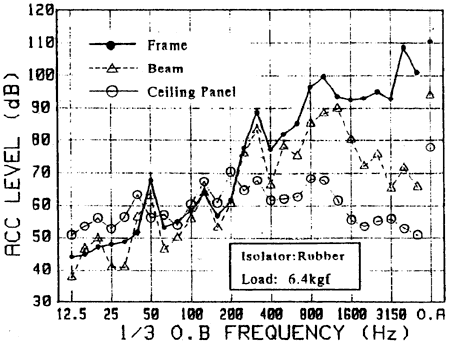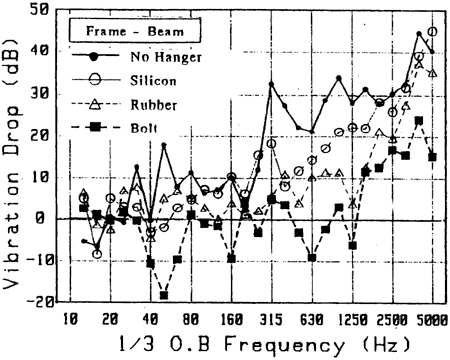Four edges are fixed by tapping screws to the walls with L-shaped steel bars. Glass wool layers are attached as heat insulator, a steel beam. is attached in the middle of the ceiling and a hanger is connected between the steel frame and the beam, Four types of isolator, an ordinary rubber, a silicon based isolator (abbreviate as silicon), a steel bolt, and no connection are tested to examine their vibration isolation effects and the influences on the ceiling vibration levels. The acceleration of the frame, the beam where the hanger is connected, and of 40 points of the ceiling are measured. The load and the displacement of the ceiling were measured when the hanger point was lifted. The dynamic stiffness of isolators is also measured by making free vibration with weights acting on them.

? Steel Frame
? Ceiling Beam
? Ceiling Pane (Glasswool attached)
? Hanger
? Isolator
? Vib. Pick up
Fig. 2 The view around a ceiling hanger
3. EXPERIMENTAL RESULTS
3.1 Vibration Isolation Effects of hangers
Examples of the acceleration measurements with a rubber isolator are illustrated in Fig. 3. In Fig. 4, vibration isolation effects of each hanger are compared. Generally, isolation effect in creases according as frequency increases. The vibration isolation effect appears above 80Hz in the case of silicon and above 315Hz when rubber isolator is employed. Even a bolt is connected, 10dB reduction was observed above 1600Hz region. The largest level difference is obtained when no hangar is connected in almost all frequency ranges, and it is determined by the isolation effect of the floating floor, the maximum value is 45db at 4kHz band. The difference of effect between rubber and silicon seems to be caused mainly the difference of the dynamic stiffness of them as shown in Table 1, but it is not confirmed that is the only reasons yet. Adopting softer isolators and many hangers as possible has the best results to reduce a ceiling vibration. In an actual case, however, it is important to consider a good balance of the effects and its cost.
Little changes in vibration isolation effects arc observed by changing the load (2.4kgf and 6.4kgf) acting on the hangar. The resonant frequency of a hanger is to be predicted when the load acting on the hanger and the dynamic stiffness of the isolator are known. However calculated resonant frequencies do not agree well to the measured values as shown in Table 2. The calculation of vibration isolation level by a mass-spring model does not agree at all to the measured ones, especially in the case where the mass is constant as 6.4kg, as illustrated in Fig. 5. Another calculation is also shown in Fig. 5, in which equivalent mass is calculated as a function of the bending eave length of a panel in the longitudinal direction of the panel and also a function of the wave length of the beam in the breadth direction.

Fig. 3 Acceleration around the Rubber Hanger.

Fig. 4 Vibration Isolation Effects of Four Hangers.
Table 1 The property of Isolators

BACK CONTENTS NEXT